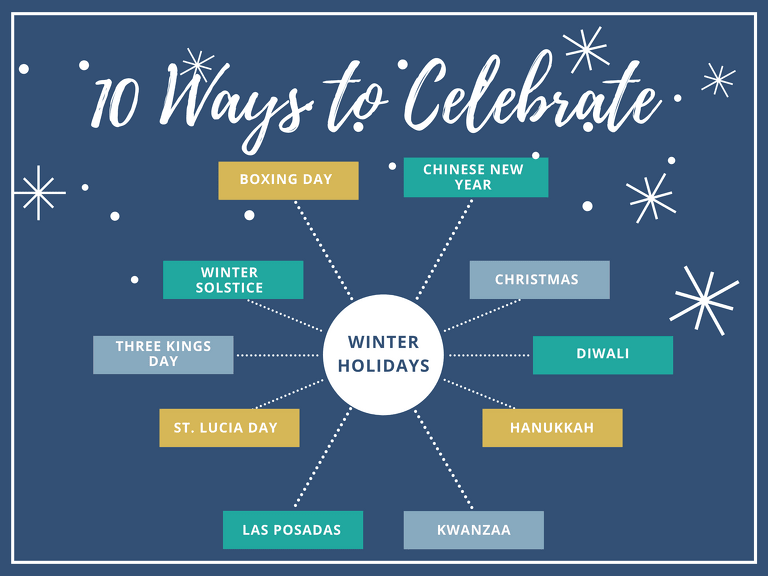Happy holidays to all!
As the winter solstice nears, us folks in the northern hemisphere are cozying up with longer nights, colder temperatures, and mugs full of hot cocoa. It’s no wonder that cultures around the globe celebrate this time of year with a central theme of bringing light into darkness.
We would like to recognize many of the wonderful holidays and traditional practices from different cultures, regions, and religions that are celebrated during this time. We can’t promise a comprehensive list here, though we tried our best. And if you have a special tradition or way to celebrate, we would love to hear about it!
Hanukkah
Hanukkah is the Jewish eight-day “festival of lights,” celebrated with a nightly menorah lighting. The holiday celebrates the triumph of a small group of brave Jews in the 2nd century BCE who stood up against genocide. The “miracle of lights” is replicated in the menorah - remembering the moment when enough oil to light one candle lasted for 8 nights. It is customary to eat foods fried in oil during Hanukkah. People often eat the potato latke, garnished with applesauce or sour cream, and the jelly-filled sufganya (doughnut).
Christmas
Christmas is an annual festival commemorating the birth of Jesus Christ, observed primarily on December 25th. Many Americans, especially Christians, will go to church to celebrate. In the Southwest, there are special customs which have some similarities to those in parts of Mexico. These include “luminarias” or “farolitos” which are paper sacks partly filled with sand and a candle. Homes are adorned with lights and decorations, and cookies and milk are left out as a snack for Santa on Christmas Eve!
Kwanzaa
Kwanzaa is a cultural holiday that celebrates African heritage and identity. The name, Kwanzaa, comes from the Swahili phrase “matunda ya kwanza,” which translates to “first fruits,” and the holiday is based on traditional African harvest festivals. In 2022, Kwanzaa is celebrated from December 26th to January 1st. During this holiday, seven candles are lit and observants place seven symbols around their home: umoja (unity), Kujichagulia (self-determination), Ujima (collective work and responsibility), Ujamaa (cooperative economics), Nia (purpose), Kuumba (creativity), and Imani (faith).
Saturnalia
Western culture owes many of the traditional midwinter celebrations - including those of Christmas - to Saturnalia, an ancient Roman solstice celebration dedicated to Saturn, the god of agriculture and time. Though it started out as a one-day celebration earlier in December, this pagan festival later expanded into a riotous weeklong party stretching from December 17th to 24th. During this jolliest and most popular of Roman festivals, social norms fell away as everyone indulged in gambling, drinking, feasting and giving gifts.
Diwali
Every year in the winter, Hindus around the world celebrate Diwali, or Deepavali - a festival of lights that stretches back more than 2,500 years. In India, the five-day celebration traditionally marks the biggest holiday of the year. It symbolizes the spiritual victory of light over darkness, good over evil, and knowledge over ignorance.
Boxing Day
Boxing Day, in Great Britain and some Commonwealth countries, particularly Australia, Canada, and New Zealand, is a holiday in which servants, tradespeople, and the poor traditionally were presented with gifts. By the 21st century it has become a day associated with shopping and sporting events.
Lunar New Year
China’s Lunar New Year is known as the Spring Festival. Tied to the lunar calendar, the holiday began as a time for feasting and honoring household and heavenly deities and ancestors. Each year in the Lunar calendar is represented by one of 12 zodiac animals included in the cycle of 12 stations or “signs” along the apparent path of the sun through the cosmos. In 2023, the New Year begins January 22!
Dongzhi
The Chinese celebration of the winter solstice, Dong Zhi (which means “Winter Arrives”) welcomes the return of longer days and the corresponding increase in positive energy in the year to come. Occurring only six weeks before the Chinese Lunar New Year, the festival remains an occasion for families to join together to celebrate the year that has passed and share good wishes for the year to come.
Three Kings Day
At the end of the Twelve Days of Christmas comes a day called the Epiphany, or Three Kings Day. This holiday is celebrated as the day the three wise men first saw baby Jesus. On this day in Spain, many children receive their Christmas presents. In Puerto Rico, children leave a box with hay under their beds so the kings will leave them presents. In France, a delicious "kings' cake" known as la galette des rois is baked. Bakers hide a coin, jewel, or toy inside it.
Las Posadas
Las Posadas is a religious festival celebrated in Mexico and some parts of the United States between December 16th and 24th. Las Posadas commemorates the journey that Joseph and Mary made from Nazareth to Bethlehem in search of a safe refuge where Mary could give birth to baby Jesus. Each evening during the festival, a small child dressed as an angel leads a procession through the streets of the town. Mass is held each day after the procession, and, at the conclusion of the service, children break open piñatas filled with candy, toys, and, occasionally, money. The piñatas are usually crafted in the form of a star, which is said to have guided the three wise men to the newborn Jesus.
Saint Nicholas Day
Saint Nicholas Day, also called the Feast of Saint Nicholas, is celebrated as a Christian festival with particular regard to Saint Nicholas' reputation as a bringer of gifts, as well as through the attendance of church services. In parts of northern Europe, Saint Nicholas Day has remained a time when children are given special cookies, candies, and gifts. In many places, children leave letters for St. Nicholas and carrots or grass for his donkey or horse. In the morning, they find small presents under their pillows or in the shoes, stockings, or plates they have set out for him.
St. Lucia’s Day
This traditional festival of lights in Scandinavia honors St. Lucia, one of the earliest Christian martyrs. According to the old Julian Calendar, December 13th (the date that is traditionally given as the day in 304 A.D. when the Romans killed Lucia for bringing food to persecuted Christians hiding in Rome) was also the shortest day of the year. As a symbol of light, Lucia and her feast day blended naturally with solstice traditions such as lighting fires to scare away spirits during the longest, darkest night of the year. On St. Lucia’s day, girls in Scandinavia wear white dresses with red sashes and wreaths of candles on their heads, as an homage to the candles Lucia wore on her head to light her way as she carried the forbidden food in her arms.
Shab-e Yalda
On the longest night of the year, Iranians all over the world celebrate the triumph of Mithra, the Sun God, over darkness in the ancient festival of Shab-e Yalda (“Night of Birth”). According to tradition, people gather together on the longest night of year to protect each other from evil, burning fires to light their way through the darkness and performing charitable acts. Friends and family join in making wishes, feasting on nuts, pomegranates and other festive foods and reading poetry. Some stay awake all night to rejoice in the moment when the sun rises, banishing evil and announcing the arrival of goodness.
Toji
In Japan, the winter solstice is less a festival than a traditional practice centered around starting the new year with health and good luck. It’s a particularly sacred time of the year for farmers, who welcome the return of a sun that will nurture their crops after the long, cold winter. People light bonfires to encourage the sun’s return, and huge bonfires burn on Mount Fuji each December 22nd. A widespread practice during the winter solstice is to take warm baths scented with yuzu, a citrus fruit, which is said to ward off colds and foster good health. Many public baths and hot springs throw yuzu in the water during the winter solstice. Many Japanese people also eat kabocha squash - known in the United States as Japanese pumpkin - on the solstice, as it is thought to bring luck.
We want to wish everyone a warm and peaceful holiday season, in all the ways you celebrate. Our next newsletter will arrive in 2023 on January 6, but please know that we are available to chat about real estate or life through the holidays. Don’t hesitate to reach out to Jess or Alissa for anything at all!
Sources: Massachusetts Institute of Technology, History, National Geographic, and Brittanica





